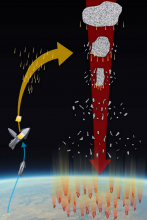Listen to today's episode of StarDate on the web the same day it airs in high-quality streaming audio without any extra ads or announcements. Choose a $8 one-month pass, or listen every day for a year for just $30.
You are here
American Craters
Chesapeake Bay, on the coast of Maryland and Virginia, is best known for its blue crabs, clams, and other seafood delicacies. It attracts anglers, birdwatchers, and other visitors from around the world — there to enjoy its great natural beauty.
But the bay was born from a cosmic cataclysm. 35 million years ago, a giant asteroid slammed into the surface at 125,000 miles per hour. It blasted out a crater that’s between 25 and 50 miles wide. And it crushed layers of rock up to five miles deep.
Chesapeake is the largest impact crater in the United States, but far from the only one. Geologists have logged almost 30 confirmed craters, and a few more possible ones.
Most of them are so old that they’ve all but vanished. Wind, rain, and the motions of Earth’s crust have washed them away or buried them. But some are still recognizable as craters — especially from the air or space. And a few have left remnants that are easily visible from the ground.
Sierra Madera in Texas, for example, retains part of the crater rim. And a central peak, which formed when rock layers at the center of the impact rebounded, rises almost 800 feet above the crater floor.
The most easily recognizable crater is in Arizona. Meteor Crater formed about 50,000 years ago. Today, the crater still retains its bowl shape. It’s about three-quarters of a mile wide and almost 600 feet deep — the aftermath of a cosmic cataclysm.
Script by Damond Benningfield





